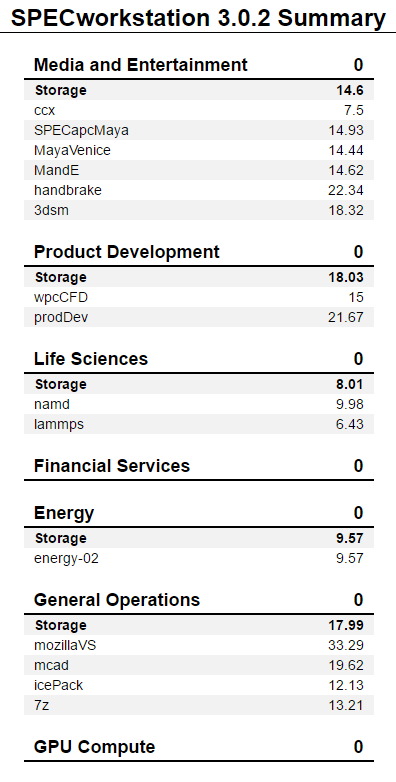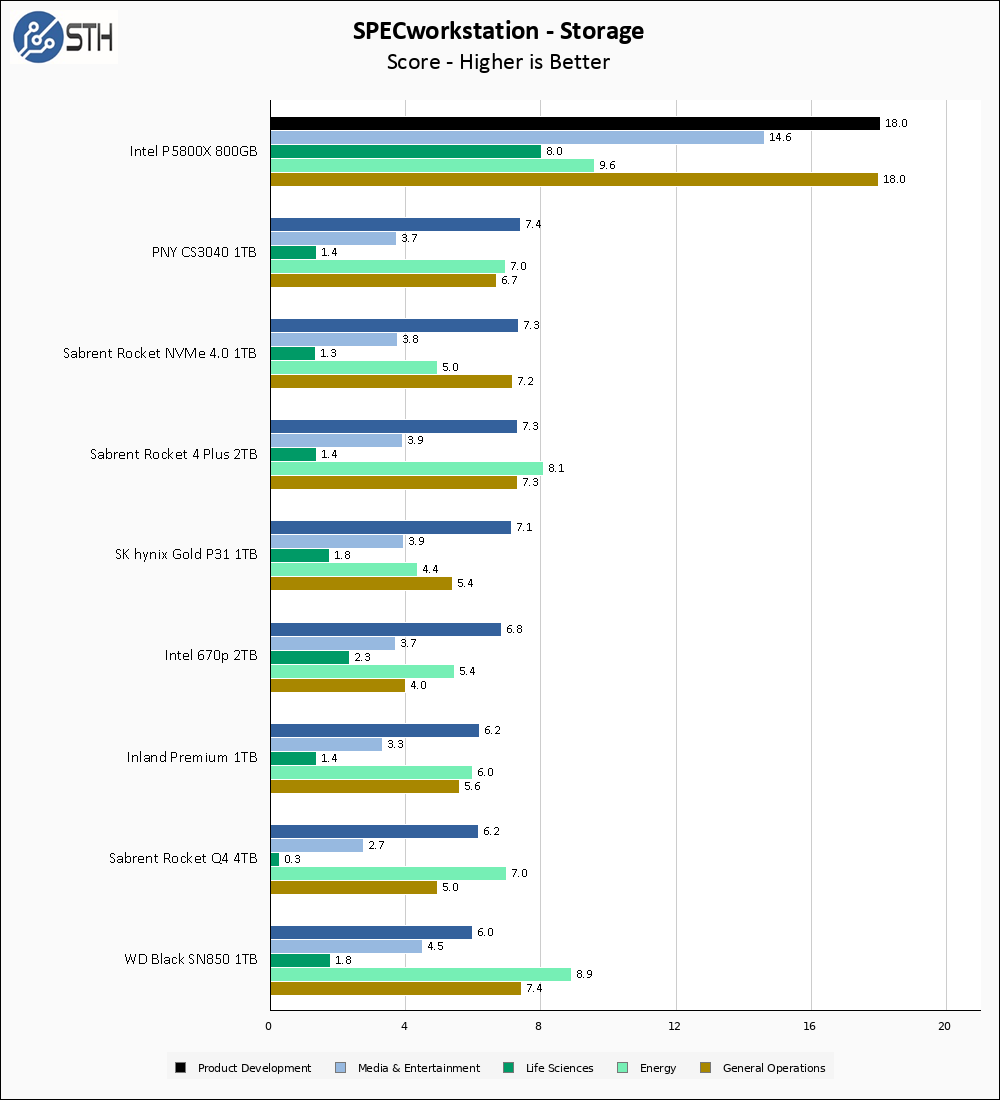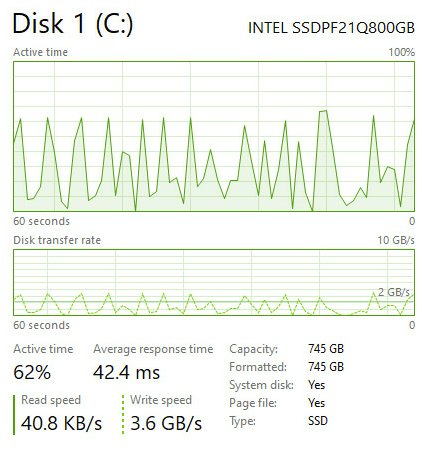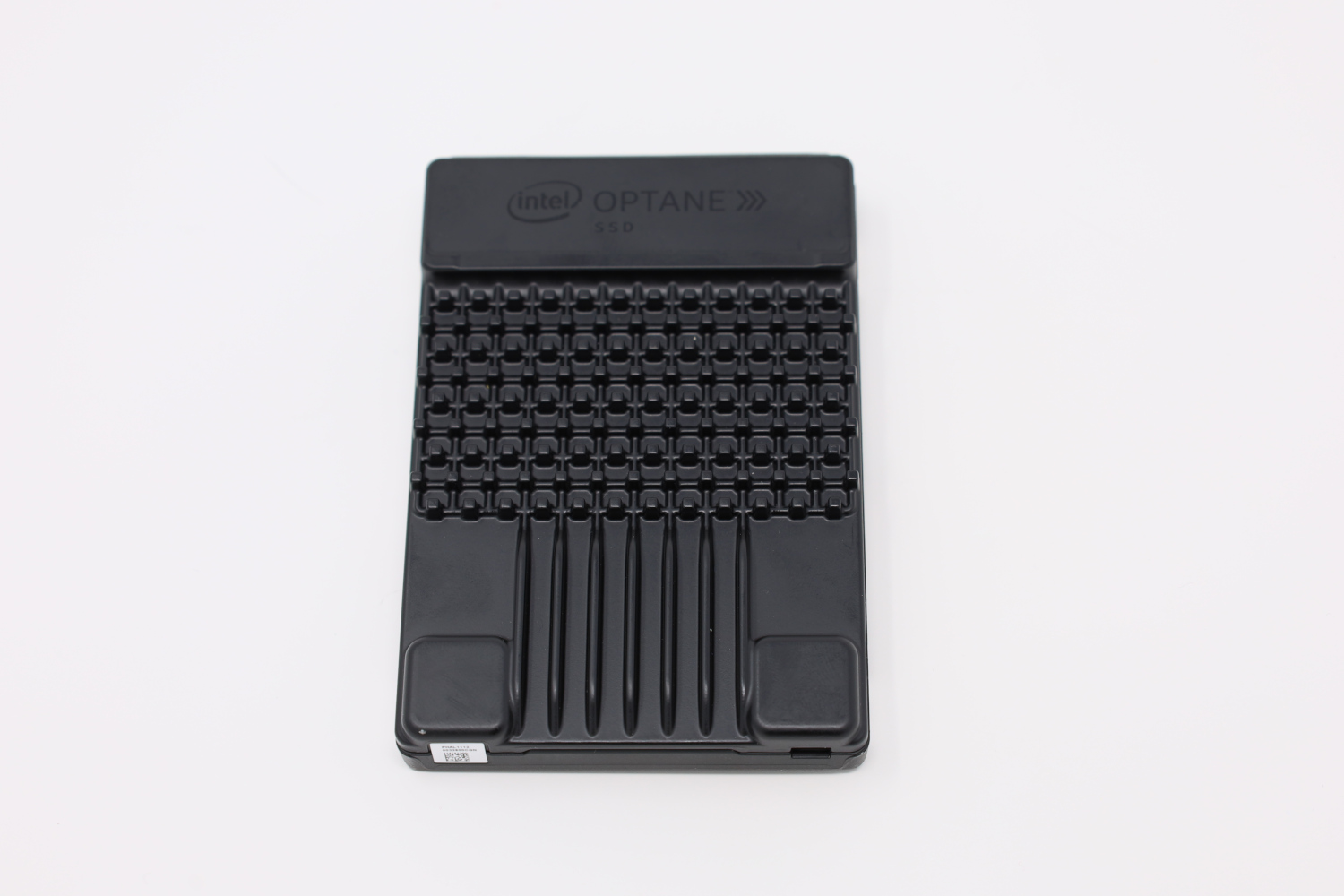SPECworkstation 3.0.2 Storage Benchmark
SPECworkstation benchmark is an excellent benchmark to test systems using workstation-type workloads. In this test, we only ran the Storage component, which is fifteen separate tests.


SPECworkstation uses real applications to run its benchmarks and provides the most hilarious demonstration of Optane’s dominance over NAND SSDs seen thus far. The P5800X wins in every subtest, often by huge margins over every other drive I have tested. It also finished the benchmark much quicker than any other drive I have tested. The degree of the lead is to the point that I may have to exclude the P5800X from appearing on this graph in future reviews to avoid skewing the chart scale.
This shows how many of the NAND SSDs do well in synthetic benchmarks, but the Optane SSDs are in a different class for real-world performance. The difference here is bigger than the difference between top-end PCIe Gen3 and Gen4 NAND SSDs, and by a large margin.
Sustained Write Performance
I am still including this section in this review, but readers should understand that it is not really applicable to the Intel Optane SSD DC P5800X. The sustained write performance test that I run operates on the assumption that a drive has a write cache that would become exhausted, and that after that cache has run out that write speeds would drop to some kind of minimum level. The Intel Optane P5800X does not have a write cache in that sense, thus write performance is consistent for the entire length of the drive.
Combined with the limits of my alternative test platform, my write performance when filling this drive to 85% was actually CPU limited rather than limited by the drive. Thus, while I will show results and even a graph, it should be understood that these results represent the limitations of my test platform and not of the P5800X.


On my test platform, I was CPU limited for most of this entire process, and in addition to that, the entire process of filling the drive took under 5 minutes. The Task Manager graph is a bit spikey, but the average speed came out pretty close to 2000 MB/s. I have no doubt this number would be higher if the processor on my test system had a higher clock and core count, but we had to make do with a backup test platform.
Temperatures
We monitored the idle and maximum temperature during testing with HWMonitor to get some idea of the thermal performance and requirements of the drive. Please keep in mind that our test bench is an open frame chassis in a 22C room, but with no direct airflow. As a result, this is not representative of a cramped low airflow case and is instead intended to model temperatures of a drive ‘on its own’.
In my testing, the Intel Optane P5800X 800GB never made it above 51C. However, the caveat to that number is that most of the time the highest temperature a SSD gets during my testing happens during the initial data load when I am writing to the drive with 10 simultaneous threads, and on the P5800X, that entire process took less than 5 minutes from start to finish. My point is, given a more intensive workload I expect it is possible for the P5800X to heat up a bit more than 51C, but it is equally obvious the bulky built-in heatsink is doing its job. Also, the speed of the drive meant that the data load happened fast allowing the drive to get back to a cooler idle state faster than we would see on a typical NAND SSD.
Final Words
The MSRP on the Intel Optane SSD DC P5800X 800GB is $2044. There is no getting around that price; this drive is not aimed even in the general direction of ‘normal’ users. For $2044, buyers could pick up 4x 2TB Sabrent Rocket 4 Plus 2TB SSDs and have a bit of money left over to buy one of those quad-M.2-on-PCIe-slot adapters and put the whole thing in RAID0. That hypothetical RAID 0 array would have 10x the capacity of the P5800X, and significantly higher sequential read and write throughput for burst workloads, though the P5800X would likely still win the day for latency-sensitive read and write applications.

Really what it comes down to is $/GB. One certainly pays more for the P5800X, and some of the synthetic numbers are close to lower-cost NAND SSDs. The Intel P5800X’s SPECworkstation results, showing real-world performance was more like jumping several generations of NAND SSDs into the future assuming NAND SSDs will hit this level of performance. For many users, the cost is not justified. For those that need every bit of performance, this is the best drive you can get.
The Optane SSD DC P5800X is simply in a different category of product and deserves to be considered as such.




Thanks Will. May I suggest two types of charts though? Showing r/w latency bar charts for the various drives compared would be useful. Also a test of sustained write to investigate behavior after DRAM cache (if any) is exhausted. Many NVMe drives post stellar write numbers until the cache is full….
Do you have a typeno on that u.2 to pci-e converter?
Are any details available on the technical issues with the Ryzen system and this Optane? Which OS was this? Just asking, as NVMe and Linux trigger a couple of trouble reports in various setups. Apparently, this is still rather new technology that, depending on the actual system/platform, may require quite a bit of work/configuration. Running NVMe on an EPYC system here as well, I would be interested in some experience.
hoohoo,
I’m guessing you didn’t read too carefully. While there are no bar charts for latency, the actual latency numbers are included on AS SSD and Anvil results. As for performing a sustained write performance test, I hid that one away in a section of the review called “Sustained Write Performance” and might answer your queries!
Navi,
Intel provided it, and it looks like a Dilink U.2 to PCIe adapter.
Think,
My Ryzen platform was listed in the review, it is a 5900X plus an ASUS PRIME X570-P motherboard, running Windows 10 20H2 (19042). The problem did seem isolated to my system specifically in some fashion, as there were no compatibility problems when running on an Epyc test system, nor the Intel system, nor any of the other reviewers that used Ryzen to test with like Jon over at TweakTown. I did not harp on the issue much because it is not a real problem if it only affects me. I will keep my ear to the ground if anyone else experiences similar issues.
Will,
My apologies, I don’t know how I missed the Sustained Write Performance section. It is indeed there.
Sorry, I am not a fan of this “U.2/PCIe” converter. You could make your point on the strength of the drive overall – sure, but comparability is imho weak considering the changed setup and that “card” (which you always pointed out).
Any chance you go for P411W-32P HBAs for testing U.2/U.3? And while at it make some benchmarks of mdadm and RAIDIX with those drives?
Why? NVME RAIDs have issues in RAID settings of RAID 4,5,6+ large arrays even in RAID 0 and RAID 1 – simply due to latency. Whereas these “beasts” probably shine in 8+ drive RAID5 arrays as SDS. Their latency overcomes most issues of SSD RAIDs.
Bottom line: to me it seems these drives enable a full array of new options in caching and hot storage. Would be nice to see how much…
I always wanted to try one of these drives but they are completely unavailable in Germany. I did notice with other drives that reformatting them to use 4KiB sectors really helps sequential speed (can be done with the nvme tools in Linux), not sure if this is also the case with Optane.
What about the iops? That is supposed to be their main benefit and didn’t see a lot of metrics in your testing.
I want this as a cache drive in my next VMware vSAN all NVMe array.
Would love to see some random I/O comparisons with this drive. Intel claims up to 5,000,000 IOPS in mixed workloads
Would love to see a test case using the P5800X as a ZIL/SLOG for ZFS sync writes. A PostgreSQL benchmark using a P5800X as a pg_wal device and another P5800X backing the database then running HammerDB against it for some metrics.
Michael, have a docker container? If so, I have two P5800X’s right now that we can use.